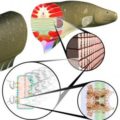
Readers might associate collagen with a celebrity’s pumped up, pouty lips, but aside from being a superficial beauty option, collagen is one of the most important structural proteins used by the human body. In fact, you’d be hard pressed to find any tissue in the body that does not rely on collagen, which is what makes the latest breakthrough in laboratory manufactured collagen so significant.
Collagen is used to reinforce bones, connective tissue, teeth and tendons, so the ability to produce synthetic collagen in the lab could revolutionize medicine. Surgeons will no longer have to rely on potentially pathogenic collagen sourced from animals – such as cows – to reconstruct damaged tissue caused by burns and other disfiguring wounds. Even catgut – a type of collagen suture used by surgeons to reduce scarring in patients – is likely to be upgraded from horse intestines to the new synthetic variety in order to avoid adverse immune responses.
Now, a team of scientists from the University of Wisconsin-Madison (UW) report in theProceedings of the National Academy of Sciences that they are confident they have discovered a method for making human collagen in the lab. The team says that success finally came when they modified the ends of the collagen snippets so that each would lock together, akin to Lego building blocks, to form the longer collagen fibers. “We can make collagen that duplicates nature exactly, but we can diverge from that when it is desirable,” says Ronald T. Raines, a UW professor of biochemistry who, with postdoctoral fellow Frank W. Kotch, authored the new study.
The discovery of a workable synthetic collagen provides scientists with more flexibility, versatility and control over the final form of the collagen. “Now we can make synthetic collagen that’s longer than natural collagen. We just don’t have to take what nature gives us. We can make it longer and stronger. We are able to build these molecules up one atom at a time and we can manipulate them in very precise ways,” said an excited Raines.
Applications for synthetic collagen seem limited only by the imagination. It could be used as “solder” to speed the healing of large wounds and could have applications in the field of nanotechnology. Human collagen coated with gold or silver and a specific biological molecule could alert diabetics to falling insulin levels, or detect harmful pathogens.









Comments are closed.